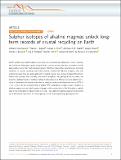Files in this item
Sulphur isotopes of alkaline magmas unlock long-term records of crustal recycling on Earth
Item metadata
| dc.contributor.author | Hutchison, William | |
| dc.contributor.author | Babiel, Ranier | |
| dc.contributor.author | Finch, Adrian A. | |
| dc.contributor.author | Marks, Michael | |
| dc.contributor.author | Markl, Gregor | |
| dc.contributor.author | Boyce, Adrian J. | |
| dc.contributor.author | Stüeken, Eva Elisabeth | |
| dc.contributor.author | Friis, Henrik | |
| dc.contributor.author | Borst, Anouk M. | |
| dc.contributor.author | Horsburgh, Nicola J. | |
| dc.date.accessioned | 2019-09-16T15:30:06Z | |
| dc.date.available | 2019-09-16T15:30:06Z | |
| dc.date.issued | 2019-09-16 | |
| dc.identifier | 260726807 | |
| dc.identifier | 5e022e07-bd92-4bd2-8ef4-345418421fdf | |
| dc.identifier | 85070786088 | |
| dc.identifier | 000485860700002 | |
| dc.identifier.citation | Hutchison , W , Babiel , R , Finch , A A , Marks , M , Markl , G , Boyce , A J , Stüeken , E E , Friis , H , Borst , A M & Horsburgh , N J 2019 , ' Sulphur isotopes of alkaline magmas unlock long-term records of crustal recycling on Earth ' , Nature Communications , vol. 10 , 4208 . https://doi.org/10.1038/s41467-019-12218-1 | en |
| dc.identifier.issn | 2041-1723 | |
| dc.identifier.other | ORCID: /0000-0002-3689-1517/work/61978757 | |
| dc.identifier.other | ORCID: /0000-0003-4553-9037/work/64698096 | |
| dc.identifier.other | ORCID: /0000-0001-6861-2490/work/65014410 | |
| dc.identifier.other | ORCID: /0000-0003-0775-1491/work/65014431 | |
| dc.identifier.uri | https://hdl.handle.net/10023/18480 | |
| dc.description | This project was supported by the European Union’s Horizon 2020 research and innovation programme under grant agreement No. 689909. S isotope analysis at SUERC was supported by a NERC Stable Isotope Facility grant (IP-1713–0517). Analysis at Tübingen was supported by the Deutsche Forschungsgemeinschaft (grant MA 2563/9–1). | en |
| dc.description.abstract | Earth’s surface and mantle sulphur reservoirs are connected via subduction, crustal recycling and volcanism. Although oceanic hotspot lavas currently provide the best constraints on the deep sulphur cycle, their restricted age range (<200 Ma) means they cannot reveal temporal variations in crustal recycling over Earth history. Sulphur-rich alkaline magmas offer the solution because they are associated with recycled sources (i.e. metasomatized lithospheric mantle and plumes) and, crucially, are found throughout the geological record. Here, we present a detailed study of sulphur isotope fractionation in a Mesoproterozoic alkaline province in Greenland and demonstrate that an enriched subduction-influenced source (δ34S of +1 to +5‰) can be reconstructed. A global δ34S compilation reveals secular variation in alkaline magma sources which support changes in the composition of the lithospheric mantle and/or Ga timescales for deep crustal recycling. Thus, alkaline magmas represent a powerful yet underutilized repository for interrogating crustal recycling through geological time. | |
| dc.format.extent | 12 | |
| dc.format.extent | 1850970 | |
| dc.language.iso | eng | |
| dc.relation.ispartof | Nature Communications | en |
| dc.subject | QD Chemistry | en |
| dc.subject | QE Geology | en |
| dc.subject | DAS | en |
| dc.subject | BDC | en |
| dc.subject | R2C | en |
| dc.subject.lcc | QD | en |
| dc.subject.lcc | QE | en |
| dc.title | Sulphur isotopes of alkaline magmas unlock long-term records of crustal recycling on Earth | en |
| dc.type | Journal article | en |
| dc.contributor.sponsor | European Commission | en |
| dc.contributor.institution | University of St Andrews. School of Earth & Environmental Sciences | en |
| dc.contributor.institution | University of St Andrews. Scottish Oceans Institute | en |
| dc.contributor.institution | University of St Andrews. St Andrews Isotope Geochemistry | en |
| dc.contributor.institution | University of St Andrews. St Andrews Centre for Exoplanet Science | en |
| dc.identifier.doi | https://doi.org/10.1038/s41467-019-12218-1 | |
| dc.description.status | Peer reviewed | en |
| dc.identifier.grantnumber | 689909 | en |
This item appears in the following Collection(s)
Items in the St Andrews Research Repository are protected by copyright, with all rights reserved, unless otherwise indicated.

